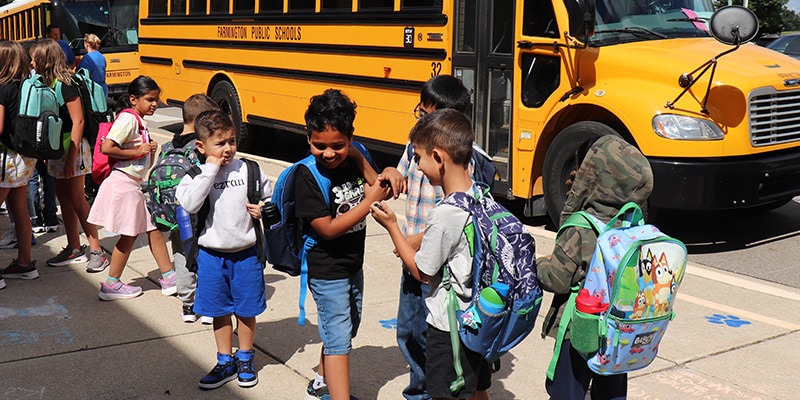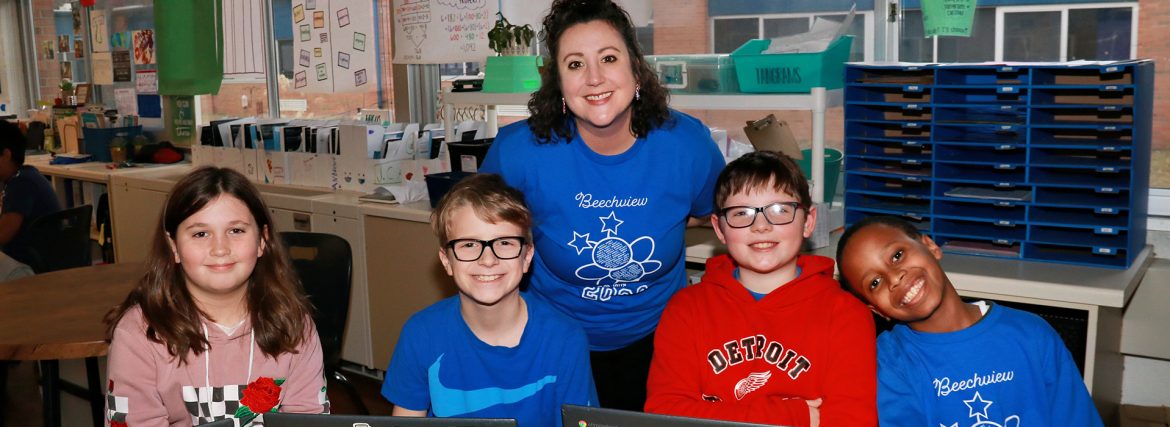Leading the Educational Pathway
Preparing Every Student for a Future of Possibilities
Serving more than 9,000 students, Farmington Public Schools (FPS) is a district focused on engagement and connection. Superintendent, Dr. Kelly Coffin describes, “We work to make sure all students are positioned within the learning so they are an active and driven participant. We focus on authentic learning, and ensuring students are heard, seen, noticed, and know that they belong.”
Margaret Hendrickson, Director of Instruction and Curriculum, emphasizes, “Our vision today really talks about each and every learner exploring their passions and interests and getting ready for their future, making sure that every student has equitable opportunities.”
Redefining the Vision
Hendrickson notes that a shift in FPS’s mission and vision came about post pandemic, as the district worked to redefine teaching and learning, and what that meant for them. “We recognized we had to change how we behaved as an organization,” she expands. “Our mission is about making sure we have a safe environment for each and every adult in the organization to investigate, reflect, innovate, and share their stories. It’s only through that that we’re going to grow and be able to get to that future aspiration of our vision.”
She adds that the district has intentionally changed its language to focus more on student learning. “If we want to prepare kids for college and career, and we want to integrate technology and career readiness K-12, we have to not only think about how we’re designing instruction, but what type of learning we want kids to do.”
Technology as a Tool
When it comes to technology, FPS’s focus is on using it to enhance collaboration and problem solving. “One of our first pieces in moving towards STEM, STEAM and technology integration was the core access to the technology,” Hendrickson remarks. “We had to think strategically about what kind of tools we would bring in. So we talked a lot about production apps that get kids thinking about their ideas, sharing, and collaborating.”
Notably, Farmington Public Schools has taken a forward looking stance on artificial intelligence, integrating it into the classroom experience. “We have an intense group of teacher leaders and central office leaders learning about AI and developing foundational messaging for our organization about the different ways teachers, administrators, and students can use the tools as a support, not a barrier,” she shares. “We actually think AI will allow us to get to the place we need to go for our vision and mission, because our students are going to be experiencing and using it in career and college, and daily as they already are.”

The district also chose to work with Michigan Virtual, learning how to provide safe and vetted access to AI. “There were many in our county that wanted to shut it down and ban it. We do not believe that that is the way that we properly support our staff and our students in our community,” Dr. Coffin imparts. “It’s important that we allow access and opportunity, but in a safe way with guidance. We never looked at it as something to ban or something to stop. We looked at it as something to embrace.”
She credits student input for helping guide that decision. “We had students come in and give us some feedback on how they were using AI already, well ahead of adults, for sure,” Coffin recalls. “What we understood from them is that it was really a resource and a tool to be more efficient and effective. It wasn’t replacing their learning. It was just accelerating and enhancing it.”
Student Voices and Experiences
The district is rich with opportunities that prepare students for life after high school. Daniel, a recent Farmington graduate headed to Lawrence Technological University, says, “You have a lot of options, like Oakland Early College, which is partnering with the local community college to dual enroll. Or you have OSTC, which is a technical college that focuses on the STEAM side of things. It gives a lot of students different opportunities, and it builds you up for your career.”
Daniel followed his interests into graphic design. “I went to OSTC, and just going to that class for a portion of my day really deepened my creative skills and my technical abilities. I have three certifications for my field already on my resume. I have multiple portfolio pieces that are looked over by professionals to make sure they’re approved and field standard. I feel like it’s given me a huge boost on where I need to be.”
Alexandria, a current senior, says her early college program has been transformative. “I’m in the Oakland ACE program, and it’s been so helpful. The program itself is around 60 credits, so it gives you such a boost for college, and it’s completely free for students,” she asserts. “I’ve known for a while that I wanted to go into something medical. But through the ACE program I’ve realized that I want to be a pediatrician. So, I’ll be taking some child development classes and things that will help me figure out my path even more.”
On the subject of lifelong learning, Daniel says, “My dad has a saying, ‘You don’t grow old, being a fool,’ and I think part of growing is learning things. If you don’t learn, you’re not going to grow as a person, become more well rounded and a better citizen.” Alexandria agrees, adding, “Being able to communicate is such an important part of learning. Building connections with people is invaluable.”
Investing in Learning Spaces
The Farmington community supported a bond in 2020 that helped the district invest in infrastructure improvements. “We’re just wrapping up that work,” reports Dr. Coffin. “A lot of it was to our buildings, and some of the basic needs for all of our schools, but now we’re moving forward into our program needs.”

The investment is also helping create innovative new spaces, including a 5000 square foot multipurpose area focused on STEAM and STEM. “That infrastructure can be as small as some new furnishings to start, all the way up to knocking down walls and creating spaces for teachers to work collaboratively and have our students be able to have the space to work in small groups and work independently, or as a large group as necessary,” Dr. Coffin expands.
Hendrickson continues, “We talk a lot about collective practice for collective impact. So all the conversations around staffing models, changing room layouts, flexible furniture, thinking about what’s on the walls, is so the system and the classroom experience align. It’s not just the work of the teachers, it’s the work of the whole system.”
Safety, Belonging and Collaboration
When it comes to safety, Farmington Public Schools recognizes the importance of connection. “In order for us to feel safe and secure, we need to have those key relationships across every person in our buildings and in our district,” acknowledges Dr. Coffin. “That’s really our focus, making sure that our students are heard and seen and noticed, and they have a caring and trusted adult throughout the day.” Partnerships with the cities of Farmington and Farmington Hills strengthen that effort, ensuring the presence of school liaison officers in every building. In addition, the district has added hall monitors at the high schools.
Community connection is another priority for the district. Hendrickson relays, “This was the first year of our community showcase, bringing our nonprofits, our government agencies, our for-profit businesses and community into the schools where students and staff can interact, build relationships and understand each other’s worlds.”
Partnerships with external organizations such as Learning Works, New Tech Network, Knowledge Works, and Michigan’s Future of Learning Council have also been critical. “We could not have done what we’ve done in the accelerated way we’ve done it without educational partners,” underscores Hendrickson. “It’s that work that is now inspiring the local partnerships we’re going to be building with our community to ensure they are an outcome and an input to our educational system.”
A Bright Future Ahead
As the district continues to evolve, Dr. Coffin says expanding opportunities for every student is a top priority. She recounts, “We get to serve one of the most diverse communities in our state, and that is an absolute joy and an absolute pleasure. Moving forward, we are going to continue to expand our STEM and STEAM, and we are going to accelerate our work in connecting our current students with future roles.”

Along with this, Farmington Public Schools will continue to optimize its partnerships, city, county, and statewide. “We want to make sure that before they leave us, our students have everything they need to successfully enter the next phase of their life, whatever that may be,” she concludes. “We want them to really drive the learning for themselves to ensure they’re prepared for their future, not for the future we once had.”
AT A GLANCE
Who: Farmington Public Schools
What: A K-12 school district serving 9000 students
Where: Farmington MI
Website: www.farmingtonk12.mi.us
PREFERRED VENDORS/PARTNERS
LearningWorks: www.learning-works.org
LearningWorks partners with innovative school districts like Farmington to reimagine education through authentic, competency-based learning. We help educators design meaningful, community-connected experiences that replace rote instruction with real-world purpose. By building local expertise, we empower educators and inspire students to thrive.
Wakely Associates, Inc./Architects: www.wakelyaia.com
Wakely Associates, Inc. relies on the experience of its Architects with over 74 years of experience working on various design projects. We take pride in providing the best customer service for our clients by bringing a TEAM approach to our projects which sets us apart from other Architecture firms.



